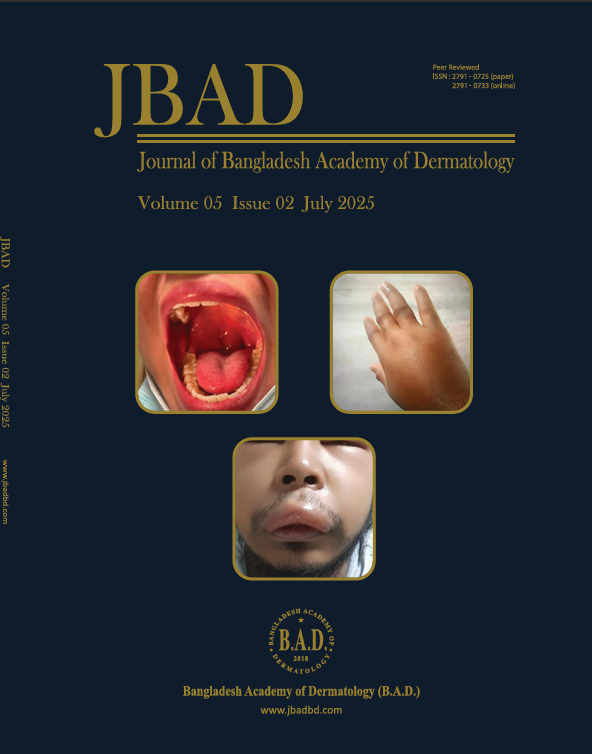Original Article
Clinico-mycological pattern of dermatophyte infection and their sensitivity to antifungal drugs
Author Details
1. Consultant, Chittagong American hospital, Agrabad, Chittagong, Bangladesh.
2. Associate professor, Department of Dermatology and Venereology, Bangabandhu Sheikh Mujib Medical University (BSMMU), Dhaka, Bangladesh.
3. Professor, Department of Dermatology and Venereology, Bangabandhu Sheikh Mujib Medical University (BSMMU), Dhaka, Bangladesh.
4. Assistant professor, Department of Dermatology and Venereology, Bangabandhu Sheikh Mujib Medical University (BSMMU), Dhaka, Bangladesh.
5. Assistant professor, Sirajul Islam Medical College, Dhaka, Bangladesh.
Abstract Background: Most of the existing antifungal drugs failing to produce satisfactory responses against dermatophyte infection and making it difficult to cure. By assessing in vitro antifungal sensitivity of currently available antifungal drugs will help to select appropriate medicine. Objective: This study was aimed at identifying the clinical and mycological pattern of dermatophyte infection in patients and to obtain the sensitivity pattern of the dermatophytes against five commonly used antifungals (fluconazole, itraconazole, terbinafine, griseofulvin, ketoconazole). Methods: Patients attending the outpatient department of dermatology at Bangabandhu Sheikh Mujib Medical University (BSMMU) clinically diagnosed with dermatophytosis were enrolled in the study. The sample was collected for mycological examination and in vitro antifungal sensitivity testing was done on species isolated from culture. Results: Tinea corporis was the most common clinical type of human dermatophyte infection. Trichophyton rubrum was the commonest (96%) dermatophyte followed by Trichophyton mentagrophyte (3%) and Epidermophyton floccosum (1%). Terbinafine (97.9%) and itraconazole (88.5%) was most sensitive, followed by ketoconazole (59.4%), fluconazole (22.9%) and griseofulvin (15.5%) against T. rubrum. Terbinafine (100%), itraconazole (66.7%), ketoconazole (66.7%) and griseofulvin (33.3%) were sensitive, and fluconazole (100%) was resistant against all cases of T. mentagrophyte species. Against E. floccosum species Terbinafine, Itraconazole, Ketoconazole and Griseofulvin were sensitive (100%) and Fluconazole was resistant (100%). Conclusion:
Terbinafin and itraconazole are sensitive against all types of dermatophytes
whereas griseofulvin and fluconazole are mostly resistant. |
Keywords: Antifungal, Resistance, Sensitivity, Dermatophytes

